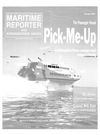
U.S. Builders Make Waves At Year End
While consolidation and closures continue to reshape the ship and boatbuilding industry worldwide, 1999 ended on some positive notes, particularly for ship and boat building companies in the United States. U.S. builders, who have watched U.S. Navy business dwindle for more than a decade, have invested hundreds of millions of dollars to restructure their shipyards. The result: a smaller but more capable base of companies that are geared to fulfill demands of traditional clients down the block as easily as they fulfill the demands of customers around the world. A recent swing through the vibrant Gulf of Mexico region helped to quantify the strides that have been made. In particular, much capital has been expended in improving the capabilities processing and cutting steel. In fact, many of the GOM area yards currently have or will soon get some of the most innovative steel processing and cutting facilities in the world. From Steiner Shipyard's new subsidiary company — Enviro-Metals — in Bayou La Batre, Ala., to Bender's new First Operations Shop in Mobile, Ala, to Litton-Avondale's now thoroughly proven steel processing facility and Bollinger's enhanced capabilities, yards large and small have studied, emulated and improved on some of the world's premiere ship and boat building installations.
Prospects: 2000 and Beyond The past year was marked by a steady stream of unique and technically challenging orders being placed and beginning progress in U.S. yards. Last year saw arguably the most significant new passenger ship order in U.S. history when American Classic Voyages' (AMCV) contracted with Litton's Ingalls Shipbuilding to build the first U.S.-flag cruise ships in more than 40 years. The $1,4-billion Project America ship (see related story, page 26) is for two 1,900-passenger vessels, scheduled for delivery in 2003 and 2004. The fleet will sail under the United States Lines company name, will operate weekly cruises to the U.S. Hawaiian Islands.
San Diego-based National Steel and Shipbuilding Company (NASSCO) — a General Dynamics company — has had its hand in an number of interesting projects, most recently winning a $300 million contract to build two RoRo vessels for Totem Ocean Trailer Express (TOTE) of Anchorage, Alaska. NASSCO will build two 839 ft. (255.7 m) RoRo vessels for its Alaska service.
According to Robert P. Magee, TOTE's president and CEO. "This $300 million private investment will further our com- mitment to Alaskans well into the next century by enhancing Alaskan job opportunities on our vessels and shoreside." The new vessels will be the same size as TOTE's existing three ships, "while maintaining extra capacity to fulfill any surge cargo needs and allow for seamless service during dry docks," Magee said. In the first part of the year, NASSCO signed a Memorandum of Understanding for the building of the first generation high-speed vessels comprised of the FastShip trans-Atlantic transportation tleet. FastShip is a gas turbine powered vessel concept that aims to economically fill the void between air transport and traditional ship transport.
Under the proposed agreement, NASSCO, designer and builder of new ships headquartered in San Diego, will construct four revolutionary vessels in the FastShip fleet. The agreement establishes a timeline to finalize a construction contract to include definitive pricing, delivery schedule and performance guarantees. NASSCO has also agreed to consider a financing commitment to FastShip, Inc. Powered by five marinized aero-derivative gas turbines, each turbine will drive one Kamewa water jet. delivering a total of 250 MW or 335,000-hp.
Earlier in the fall NASSCO was named the prime contractor on $17.4 million in research and development contracts awarded by the MARITECH Advanced Shipbuilding Enterprise (ASE) Program. In addition to the funds awarded by MARITECH, industry participants will invest $23.5 million of their own funds in the projects for a total program cost of $40.9 million.
NASSCO will lead a team of U.S.
shipbuilders, marine design and technology firms, and universities on two threeyear projects to develop advanced systems for the construction of Navy and commercial ships. In mid-December, NASSCO launched USNS CHARLTON, the fifth strategic sealift ship being built for the U.S. Navy by NASSCO.
Measuring 950 x 105 ft. (290 x 32 m), the strategic sealift ships are the largest ships ever launched down a sliding ways in the U.S.
Other stories from January 2000 issue
Content
- Editor's Note page: 6
- A Manta in Dutch environs page: 8
- Good opening round for German contender page: 10
- Dutch small-ship prowess page: 10
- Holland America Contracts Fincantieri For Two page: 12
- Samsung Heavy Rings Up Significant Orders To Usher In New Year page: 13
- Totem Enters Into Agreement With NASSCO page: 14
- Perkins Sabre Launches Two New Engines page: 18
- Offshore Supply Vessels Rebuilt - Cargo Handling, Tank Sounding Automated page: 20
- Transas Launches Stand-Alone Engineroom Simulator page: 21
- VTC Expands Possibilities With Cutler-Hammer Agreement page: 21
- Columbia Coastal Christens Super Barge page: 22
- Pilot Boat Features New Hull Design page: 23
- Schlumberger Launches Deepwater Vessel page: 23
- Cascade Signs Maintenance/Repair Agreement page: 24
- Verolme Botlek Carries Out Vessel Upgrades page: 24
- Argent To Reactivate LNG Carrier page: 25
- United States Lines Flying High Again page: 26
- "Boutique" Cruise Vessel Keeps French Cruisers Nicely Coiffed page: 26
- SeaArk Marine's Atlantis Explorer page: 28
- HMS: Outfitting ferry for safety, success page: 29
- Passenger Vessel Report page: 30
- Austal To Start U.S. Shipbuilding Joint Venture page: 31
- Passenger Vessel Report page: 32
- Finnegan Joins Drew Marine page: 45
- The Coating Conundrum page: 46
- U.S. Builders Make Waves At Year End page: 51
- Alabama Launches ATB page: 52
- Deutz Augments Lower Power Range With New Engines page: 80
- Deere adds 8.1 L Engine to Line page: 80

